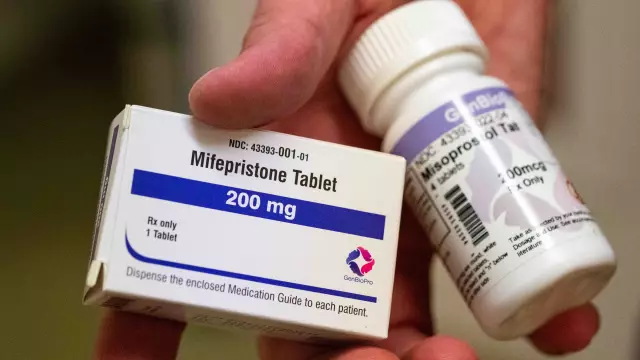- Author Rachel Wainwright [email protected].
- Public 2023-12-15 07:39.
- Last modified 2025-11-02 20:14.
Blood after abortion
In everyday life, abortion is understood as an artificial termination of pregnancy.

The normal course of the period after an abortion is the key to a successful recovery of the body after a traumatic intervention. An important question is how much blood goes after an abortion. This article is devoted to this topic.
What is bleeding after interruption
Blood loss after an abortion is normal. On the day of scraping or vacuum aspiration, the vessels of the uterine wall are damaged. Any pregnancy is always accompanied by increased blood supply to the genitals, so abortion is accompanied by profuse bleeding. If the period after the intervention proceeds favorably, then in the next few hours the abundant discharge ends.
The next stage in blood loss after an abortion is a normal menstrual reaction. This bleeding begins on days 2-4 and is similar to regular periods. The blood has a brownish tint, its volume per day is small. Sometimes this blood discharge after an abortion has clots. This is considered the norm, since the remnants of the ovum leave the uterus. The menstrual reaction should not exceed 10 days. A new cycle is counted from its first day. The next period should come in 21-40 days.
The period after drug abortion has some differences. In this case, there is no mechanical damage to the vessels. Blood loss after this type of abortion is similar to your regular period. However, the later the interruption is done with pills, the higher the risk of serious bleeding.
What kind of blood discharge after an abortion is dangerous
Excessive bleeding after induced abortion can be life threatening for a woman. The amount of blood loss can be assessed independently. Normally less than 4 maxi size sanitary towels should be used per day. The type of blood after an abortion is of great importance. The greatest danger is the release of scarlet blood. It is important to assess not only blood loss but also other symptoms after interruption. The reason to seek medical attention should be an increase in body temperature. Severe pain in the lower abdomen also cannot be ignored.
Factors Affecting Blood Discharge After Abortion
Any artificial termination of pregnancy is a serious trauma for the female body. Full recovery takes a long time. Discharge of blood after an abortion is a normal reaction of the genitals to the intervention. It always takes some time for the inner layer of the uterine wall to return to normal. How much blood goes after an abortion is influenced by a number of reasons. The most important factor is considered the type of abortion suffered. The time when it was fulfilled also plays an important role. Other important points are the qualifications of the gynecologist, the state of the blood coagulation system, the presence of abortion and childbirth in the past, the age of the pregnant woman, and the presence of gynecological diseases.
The greatest blood loss is provoked by a standard surgical abortion with curettage of the walls of the uterus. This intervention is performed for 7-12 weeks. Vacuum aspiration and medication to terminate a pregnancy usually produce less blood after an abortion.
Discharge of blood after an abortion is associated with the duration of pregnancy. The more weeks a woman is delayed, the more blood she will lose after an abortion.
Diseases of the blood coagulation system generally predispose to prolonged bleeding. Greater blood loss after interruption can be associated with these conditions.
Multiple abortions and recent childbirth also contribute to profuse blood loss. Among gynecological diseases, endometriosis and infectious diseases have the maximum effect on blood discharge after abortion.
How much blood goes after an abortion is normal
Drug termination of pregnancy provokes bleeding 3-4 days after taking the first pills. At the beginning, a lot of blood is released after an abortion. The first two days, bleeding exceeds the volume of normal menstruation. Further, the intensity of the discharge begins to decrease and stops completely within a week. A medical abortion for more than 7 weeks is sometimes accompanied by profuse bleeding. That is why gynecologists recommend hospitalization in a gynecological hospital in such a situation.
Mini abortion is a conservative intervention. There may be a slight discharge on the day of the procedure. Then, on day 2-4, menstrual bleeding begins. This reaction of the body normally lasts 4-6 days.
A lot of blood is lost after an abortion with curettage. Heavy bleeding continues for several hours. This is directly related to vascular damage to the uterine wall. After scraping, its entire inner surface is actually an open wound. The entire period of bleeding, the woman is under the supervision of medical personnel. She is injected with drugs that help to contract the muscles of the uterus. Oxytocin injections are most commonly performed.
Further, the discharge stops for a while. A menstrual reaction occurs 2-4 days. Its duration should not exceed 10 days. The longer the gestational age, the more blood will be lost after the abortion.

If the interruption is performed after 9 weeks, then a small amount of blood may be discharged within a month after the intervention. Bleeding after scraping is not only considered normal, but is also a necessary stage in the recovery period. If blood is not released after an abortion, then something is preventing its outflow. The fluid accumulated inside the uterus provokes inflammation.
Prevention of complications in the period after abortion
To minimize the damage to health after artificial termination of pregnancy, you must adhere to medical recommendations. Maintaining personal hygiene, taking prescribed medications and not having an intimate life for 30 days will help the body recover. All month a woman should refrain from taking baths, lifting weights, and avoiding hypothermia.
Blood loss after abortion can be replenished with iron-rich foods. The diet must include dishes from beef, liver, eggs. Sometimes doctors advise to drink special drugs against anemia, such as Sorbifer Durules or Fenuls.
YouTube video related to the article:
Found a mistake in the text? Select it and press Ctrl + Enter.






